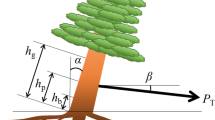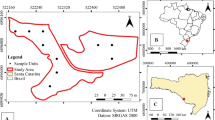Abstract
Static winching tests were carried out in order to determine the mechanical resistance of Maritime pine to overturning. The tested stands were selected according to podzolic soil conditions: “wet Lande”, characterised by a shallow ground water table and a hard pan horizon, and “dry Lande”, with a deeper ground water table and a hard pan absent or broken up. As this soil horizon limits the vertical growth of tree roots, anchorage resistance was investigated with regards to the presence or absence of a hard pan underneath each tree. To determine if mechanical behaviour differed within a stand, trees from inside the stand and edge trees at the border exposed to prevailing winds were also tested. The critical turning moment (TMcrit,total) at the base of the stem was positively related to the variable (H × DBH2) (H, total tree height; DBH, tree diameter). Linear regression analyses between TMcrit,total and (H × DBH2) showed that the presence of a hard pan had no significant effect on anchorage resistance in uprooted trees. Stem failure occurred for 82% of trees on dry Lande when (H × DBH2) < 1 m3. Moreover, stem failure type on dry Lande indicated that trees were better anchored. On soil with a hard pan, edge trees were found to be 20% more resistant to overturning than inner trees. Edge trees differed from inner trees in that the soil-root plate was two times larger and also possessed a larger surface area on the windward side.



Similar content being viewed by others
References
Coutts MP (1983) Root architecture and tree stability. Plant Soil 71:171–188
Coutts MP (1986) Components of tree stability in Sitka spruce on peaty gley soil. Forestry 59:173–197
Danjon F, Bert D, Godin C, Trichet P (1999) Structural root architecture of 5-year-old Pinus pinaster measured by 3D digitising and analysed with AMAPmod. Plant Soil 217:49–63
Fraser AI (1962) The soil and roots as factors in tree stability. Forestry 35:117–127
Fredericksen TS, Hedden RL, Williams SA (1993) Testing loblolly pine wind firmness with simulated wind stress. Can J For Res 23:1760–1765
Gardiner BA, Stacey GR, Belcher RE, Wood CJ (1997) Field and wind tunnel assessments of the implications of respacing and thinning for tree stability. Forestry 70:233–252
Gardiner BA, Peltola H, Kellomaki S (2000) Comparison of two models for predicting the critical wind speeds required to damage coniferous trees. Ecol Model 129:1–23
Jolivet C, Arrouays D, Andreux F, Leveque J (1997) Soil organic carbon dynamics in cleared temperate forest spodosols converted to maize cropping. Plant Soil 191:225–231
Meunier S, Ruel JC, Laflamme G, Achim A (2002) Résistance comparée de l’épinette blanche et du sapin baumier au renversement. Can J For Res 32:642–652
Mickovski SB, Ennos AR (2002) A morphological and mechanical study of the root systems of suppressed crown Scots pine Pinus sylvestris. Trees 16:274–280
Moore JR (2000) Differences in maximum resistive bending moments of Pinus radiata trees grown on a range of soil types. For Ecol Manage 135:63–71
Nicoll BC, Ray D (1996) Adaptive growth of tree root systems in response to wind action and site conditions. Tree Physiol 16:891–898
Nicoll BC, Easton EP, Milner AD, Walker C, Coutts MP (1995) Wind stability factors in tree selection: distribution of biomass within root systems of Sitka spruce clones. In: Coutts MP, Grace J (eds) Wind and trees. Cambridge University, Cambridge, pp 276–292
Oliver HR, Mayhead GJ (1974) Wind measurements in a Pine forest during a destructive gale. Forestry 47:185–194
Papesch AJG, Moore JR, Hawke AE (1997) Mechanical stability of Pinus radiata trees at Eyrewell Forest investigated using static tests. N ZJ For Sci 27:188–204
Pardé J, Bouchon J (1988) Dendrométrie. ENGREF, Nancy
Peltola H, Kellomaki S, Hassinen A, Granander M (2000) Mechanical stability of Scots pine, Norway spruce and birch: an analysis of tree-pulling experiments in Finland. For Ecol Manage 135:143–153
Ray D, Nicoll BC (1998) The effect of soil water-table depth on root-plate development and stability of Sitka spruce. Forestry 71:169–182
Savill PS (1983) Silviculture in a windy climate. For Abstr 44:473–488
Schaetzl RJ, Johnson DL, Burns SF, Small TW (1989) Tree uprooting: review of terminology, process, and environmental implications. Can J For Res 19:1–11
Smith VG, Watts M, James DF (1987) Mechanical stability of black spruce in the clay belt region of northern Ontario. Can J For Res 17:1080–1091
Somerville A (1979) Root anchorage and root morphology of Pinus radiata on a range of ripping treatments. N ZJ For Sci 9:294–315
Stokes A (1999) Strain distribution during anchorage failure of Pinus pinaster Ait. at different ages and tree growth response to wind-induced root movement. Plant Soil 217:17–27
Stokes A, Guitard D (1997) Tree root response to mechanical stress. In: Altman A, Waisel Y (eds) Biology of root formation and development. Plenum, New York, pp 227–236
Stokes A, Fitter AH, Coutts MP (1995) Responses of young trees to wind and shading: effects on root architecture. J Exp Bot 46:1139–1146
Stokes A, Nicoll BC, Coutts MP, Fitter AH (1997) Responses of young Sitka spruce clones to mechanical perturbation and nutrition: effects on biomass allocation, root development, and resistance to bending. Can J For Res 27:1049–1057
Stokes A, Berthier S, Sacriste S, Martin F (1998) Variations in maturation strains and root shape in root systems of Maritime pine (Pinus pinaster Ait.). Trees 12:334–339
Stone EL, Kalisz PJ (1991) On the maximum extent of tree roots. For Ecol Manage 46:59–102
Terzaghi K, Peck R (1967) Soil mechanics in engineering practice. Wiley, New York
Trichet P, Jolivet C, Arrouays D, Loustau D (1997) Le maintien de la fertilité des sols forestiers landais dans le cadre de la sylviculture intensive du pin maritime. In: ARBORA (eds) De la forêt cultivée à l’industrie de demain. ARBORA, Bordeaux, pp 25–44
Young DF (1972) Introduction to applied mechanics; an integrated treatment for students in engineering, life science, and interdisciplinary programs. Iowa State University, Ames
Acknowledgements
This research was supported by GIP ECOFOR (contract no. 2002.09). The authors thank E. Borg, B. Issenhuth, H. Lataillade, H. Bignalet, N. Cheval (INRA, UE Hermitage, Bordeaux, France), M. Chassagne (UMR LRBB, Bordeaux, France), J.Y. Fraysse (Afocel Sud-Ouest, France) for their helpful assistance with fieldwork; T. Fourcaud (CIRAD, LRBB, Bordeaux, France) and F. Danjon (INRA, Unité EPHYSE Bordeaux, France) for their comments of this study.
Author information
Authors and Affiliations
Corresponding author
Rights and permissions
About this article
Cite this article
Cucchi, V., Meredieu, C., Stokes, A. et al. Root anchorage of inner and edge trees in stands of Maritime pine (Pinus pinaster Ait.) growing in different podzolic soil conditions. Trees 18, 460–466 (2004). https://doi.org/10.1007/s00468-004-0330-2
Received:
Revised:
Accepted:
Published:
Issue Date:
DOI: https://doi.org/10.1007/s00468-004-0330-2




